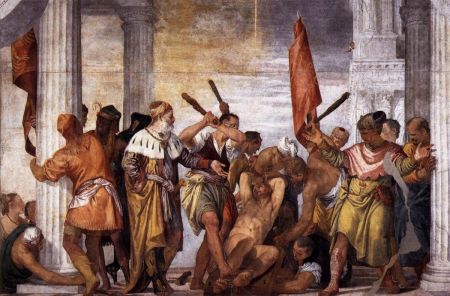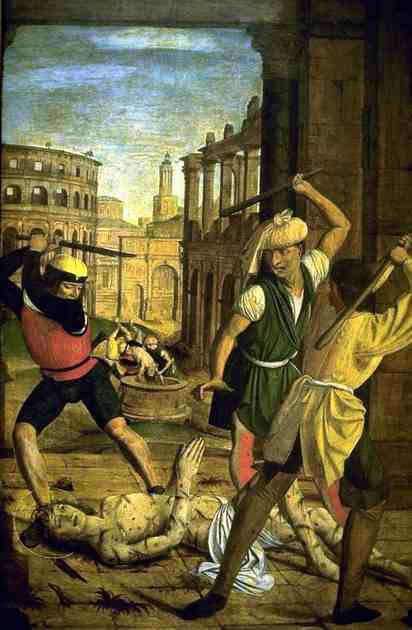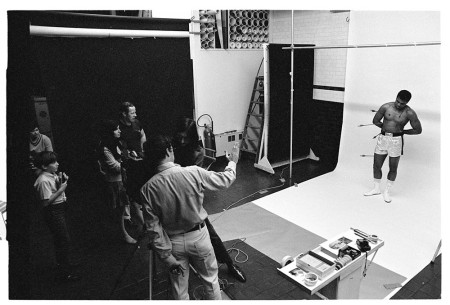 The unfortunate Saint Sebastian – I guess the saints are all unfortunate, since they all meet grisly deaths, but then, that’s their good fortune from the Christian point of view… -is a familiar figure to lovers of art history. Also familiar to male lovers of men, since his image is popular as a gay icon in wildly different forms, many in the realm of kitsch, or camp, as it were. I get that he’s a young, strapping fellow (patron saint of athletes for some reason), and the voyeuristic, masochistic, erotic aura that hangs, or can be projected about him. (Did Oscar Wilde really say that in this image he looked a bit like a “mournful pin cushion,” or is that just something my girlfriend told me in high school?) Once he was released from his martyrdom in Reading Gaol, Oscar Wilde did adopt the pseudonym, Sebastian Melmoth, the first part for the saint? and the second a reference to the long-suffering protaganist of Maturin’s early 19th century gothic tale Melmoth the Wonderer.
The unfortunate Saint Sebastian – I guess the saints are all unfortunate, since they all meet grisly deaths, but then, that’s their good fortune from the Christian point of view… -is a familiar figure to lovers of art history. Also familiar to male lovers of men, since his image is popular as a gay icon in wildly different forms, many in the realm of kitsch, or camp, as it were. I get that he’s a young, strapping fellow (patron saint of athletes for some reason), and the voyeuristic, masochistic, erotic aura that hangs, or can be projected about him. (Did Oscar Wilde really say that in this image he looked a bit like a “mournful pin cushion,” or is that just something my girlfriend told me in high school?) Once he was released from his martyrdom in Reading Gaol, Oscar Wilde did adopt the pseudonym, Sebastian Melmoth, the first part for the saint? and the second a reference to the long-suffering protaganist of Maturin’s early 19th century gothic tale Melmoth the Wonderer.
This image by Mantegna is just one of the most famous showing the saint’s martyrdom by archery at the order of Diocletian, or is it? Yes, those two fellows in the right foreground have done their duty, and tied and shot up Sebastian, a former member of the emperor’s Praetorian Guard who kept his Christianity secret so that he could give help to the persecuted Christians. He was found out, and Diocletian ordered him killed…but is he dead? He appears alive to me!
I know that saints are the subjects and producers of miracles all the time, but if their sainted martyrdom is based on being murdered for their faith, shouldn’t they…er…be dead? This set me off on a little art historical research regarding the saint, and I quickly found that he did not die from the fusillade of arrows, although you can hardly accuse the archers of negligence in carrying out orders. He did survive, miraculously, and was fetched and tended by Saint Irene. During the middle ages, because he had survived his execution by arrows, he was invoked for help against diseases, especially the bubonic plague.
Since he was undeterred by fear of death, and since his cover was quite obviously blown, his next move after recovering from his wounds was to go to the emperor’s palace, hide in an alcove or stairwell, and furiously upbraid Diocletian for his sins when he finally happened by. Naturally, the emperor was furious: not only was the man not dead as he had ordered, but he returns and insults him directly! Diocletian ordered his men to club Sebastian to death – perhaps considered a more certain technique – and then to throw his body into the sewer, sometimes noted as the cloaca maxima. Eventually, his body was retrieved, but the scenes of his actual death, and subsequent disposal and retrieval are vastly less common in art history than the picturesque and unsuccessful first try.
Here we have the saint being pitched into the sewer, as painted by Lodovico Carraci. His suspension in the air just as he is beginning to fall in seems awkward to me.

The work below, by Altdorfer, shows the saint’s body being retrieved from the sewer, or at least from out of the muck, by friends who will bury him in the catacombs near the resting places of the apostles. His body seems little the worse for his immersion in the sewer.

Scenes of Sebastian’s actual execution by clubbing are a bit more plentiful: here is one by Veronese.

Josse Lieferinxe did a set of paintings of the saint for altarpiece dedicated to him, and this image shows him being beaten to death: in the background the executioners dump his body into the sewer.

Another beating, but I have not identified the painter.

The three images below are from a tiny chapel dedicated to St. Sebastian in Venanson in southern France. The chapel is not well documented on the internet, but the painter of these frescoes is identified as Giovanni Baleison.
![[FRANCE.ALPSSOUTH 29808] ÔSt. Sebastian thrown in a sewer at Ve [FRANCE.ALPSSOUTH 29808] ÔSt. Sebastian thrown in a sewer at Venanson.Õ The ninth of twelve panels depicting the life of St. Sebastian in the Chapelle Saint-Sbastien at Venanson shows two men dumping the body of St. Sebastian in a privy. After converting the prefect of Rome to Christianity and refusing to worship Roman gods, Sebastian was executed by order of Roman Emperor Diocletian. To prevent martyr worship his body was thrown in a sewer. The mural was executed in 1481 by Giovanni Baleison, one of the so-called Ôpeintres primtifs nioisÕ (primitive painters of Nice.) This chapel is one of a series of chapels placed at the entrance to villages to protect their inhabitants against the plague. Venanson is a village in the French Alps, 40 km north of Nice. Photo Paul Smit.](https://i0.wp.com/iamyouasheisme.wordpress.com/wp-content/uploads/2018/06/29808-venanson-xl.jpg?w=205&h=216&ssl=1)
![[FRANCE.ALPSSOUTH 29809] ÔSt. Sebastian removed from a sewer at [FRANCE.ALPSSOUTH 29809] ÔSt. Sebastian removed from a sewer at Venanson.Õ The tenth of twelve panels depicting the life of St. Sebastian in the Chapelle Saint-Sbastien at Venanson shows two men pulling the body of St. Sebastian from a sewer. After converting the prefect of Rome to Christianity and refusing to worship Roman gods, Sebastian was executed by order of Roman Emperor Diocletian. To prevent martyr worship his body was thrown in a sewer. A pious lady, called Lucina, was admonished by the martyr in a vision and got SebastianÕs body privately removed and buried with dignity. The mural was executed in 1481 by Giovanni Baleison, one of the so-called Ôpeintres primtifs nioisÕ (primitive painters of Nice.) This chapel is one of a series of chapels placed at the entrance to villages to protect their inhabitants against the plague. Venanson is a village in the French Alps, 40 km north of Nice. Photo Mick Palarczyk.](https://i0.wp.com/iamyouasheisme.wordpress.com/wp-content/uploads/2018/06/29809-venanson-xl.jpg?w=237&h=356&ssl=1)
If you need a reason to take a trip to Provence, this site, and the even less documented one in Roubion should be reason enough. The only photos of individual panels of the frescoes I could find online are licensed, and have a copyright logo watermark. The two below show the saint being dumped into and retrieved from the sewer.


This image of the chapel frescoes shows the panel of the saint’s dumping in situ.

Finally, to bring us back nearer to the present, we have an image of a studio session with Muhammad Ali posing as Saint Sebastian, part of series of famous men standing in for the saint.

Sebastian’s head, or “skull cap” is preserved here, supposedly.





 Posted by Lichanos
Posted by Lichanos